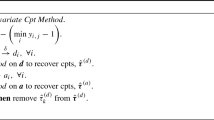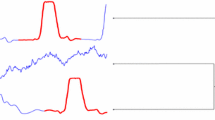Abstract
This paper presents a novel method for discovering change-points in a time series of elements in the set of rigid-body motion in space SE(3). Although numerous change-points detection techniques are available for dealing with scalar, or vector, time series, the generalization of these techniques to more complex structures may require overcoming difficult challenges. The group SE(3) does not satisfy closure under linear combination. Consequently, most of the statistical properties, such as the mean, cannot be properly estimated in a straightforward manner. We present a method that takes advantage of the Lie group structure of SE(3) to adapt a difference of means method. Especially, we show that the change-point in SE(3) can be discovered in its Lie algebra se(3) that forms a vector space. The performance of our method is evaluated through both synthetic and real-data.
Access this chapter
Tax calculation will be finalised at checkout
Purchases are for personal use only
Preview
Unable to display preview. Download preview PDF.
Similar content being viewed by others
References
Merckel, L., Nishida, T.: Towards expressing situated knowledge for complex instruments by 3D items creation and animation. In: The 8th International Workshop on Social Intelligence Design, Kyoto, Japan, pp. 301–315 (2009)
van Dam, A.: Post-wimp user interfaces. Communications of the ACM 40, 63–67 (1997)
Sezgin, T.M., Davis, R.: Scale-space based feature point detection for digital ink. In: AAAI Fall Symposium on Making Pen-based Interaction Intelligent and Natural (2004)
Fiorentino, M., Monno, G., Renzulli, P.A., Uva, A.E.: 3D sketch stroke segmentation and fitting in virtual reality. In: International Conference on the Computer Graphics and Vision, Moscow, Russia, pp. 188–191 (2003)
Qin, S.F., Wright, D.K., Jordanov, I.N.: On-line segmentation of freehand sketches by knowledge-based nonlinear thresholding operations. Pattern Recognition 34, 1885–1893 (2001)
Agarwal, M., Gupta, M., Mann, V., Sachindran, N., Anerousis, N., Mummert, L.: Problem determination in enterprise middleware systems using change point correlation of time series data. In: 2006 IEEE/IFIP Network Operations and Management Symposium NOMS 2006, pp. 471–482. IEEE, Los Alamitos (2006)
Basseville, M., Nikiforov, I.V.: Detection of Abrupt Changes - Theory and Application. Prentice-Hall, Inc., Englewood Cliffs (1993)
Ide, T., Inoue, K.: Knowledge discovery from heterogeneous dynamic systems using change-point correlations. In: SIAM International Conference on Data Mining, pp. 571–576 (2005)
Moskvina, V., Zhigljavsky, A.: An algorithm based on singular spectrum analysis for change-point detection. Communications in Statistics: Simulation and Computation 32, 319–352 (2003)
Ide, T., Tsuda, K.: Change-point detection using krylov subspace learning. In: SIAM International Conference on Data Mining, pp. 515–520 (2007)
Gombay, E.: Change detection in autoregressive time series. Journal of Multivariate Analysis 99, 451–464 (2008)
Kawahara, Y., Sugiyama, M.: Change-point detection in time-series data by direct density-ratio estimation. In: SIAM International Conference on Data Mining (2009)
Lee, J., Shin, Y.S.: General construction of time-domain filters for orientation data. IEEE Transactions on Visualization and Computer Graphics 8, 119–128 (2002)
Courty, N.: Bilateral human motion filtering. In: The 16th European Signal Processing Conference, Lausanne, Switzerland (2008)
Tuzel, O., Subbarao, R., Meer, P.: Simultaneous multiple 3d motion estimation via mode finding on lie groups. In: Tenth IEEE International Conference on Computer Vision, pp. 18–25. IEEE, Los Alamitos (2005)
Subbarao, R., Meer, P.: Nonlinear mean shift for clustering over analytic manifolds. In: Computer Vision and Pattern Recognition, pp. 1168–1175. IEEE, Los Alamitos (2006)
Fletcher, P.T., Lu, C., Joshi, S.: Statistics of shape via principal geodesic analysis on lie groups. In: IEEE Conference on Computer Vision and Pattern Recognition, pp. 95–101. IEEE Comput. Soc., Los Alamitos (2003)
Buss, S.R., Fillmore, J.P.: Spherical averages and applications to spherical splines and interpolation. ACM Trans. Graph. 20, 95–126 (2001)
Srivastava, A., Klassen, E.: Monte Carlo extrinsic estimators of manifold-valued parameters. IEEE Transactions on Signal Processing 50, 299–308 (2002)
Govindu, V.M.: Lie-algebraic averaging for globally consistent motion estimation. In: IEEE Conference on Computer Vision and Pattern Recognition, pp. 684–691. IEEE Comput. Soc., Los Alamitos (2004)
Drummond, T., Cipolla, R.: Real-time visual tracking of complex structures. IEEE Transactions on PAMI 24, 932–946 (2002)
Grassia, F.S.: Practical parameterization of rotations using the exponential map. Journal of Graphics, Gpu, and Game Tools 3, 29–48 (1998)
Stuelpnagel, J.: On the parametrization of the three-dimensional rotation group. SIAM Review 6, 422–430 (1964)
Huang, J.S.: 7. In: Introduction to Lie Groups, pp. 71–89. World Scientific Publishing Company, Singapore (2000)
Zefran, M., Kumar, V., Croke, C.: On the generation of smooth three-dimensional rigid body motions. IEEE Transactions on Robotics and Automation 14, 576–589 (1998)
Selig, J.M.: 4. In: Lie Algebra. Monographs in Computer Science, pp. 51–83. Springer, New York (2005)
Foxlin, E., Naimark, L.: Vis-tracker: A wearable vision-inertial self-tracker. In: IEEE Virtual Reality Conference, p. 199 (2003)
Hofer, M., Pottmann, H.: Energy-minimizing splines in manifolds. ACM Transactions on Graphics 23, 284–293 (2004)
Author information
Authors and Affiliations
Editor information
Editors and Affiliations
Rights and permissions
Copyright information
© 2011 Springer-Verlag Berlin Heidelberg
About this paper
Cite this paper
Merckel, L., Nishida, T. (2011). Change-Point Detection on the Lie Group SE(3). In: Richard, P., Braz, J. (eds) Computer Vision, Imaging and Computer Graphics. Theory and Applications. VISIGRAPP 2010. Communications in Computer and Information Science, vol 229. Springer, Berlin, Heidelberg. https://doi.org/10.1007/978-3-642-25382-9_16
Download citation
DOI: https://doi.org/10.1007/978-3-642-25382-9_16
Publisher Name: Springer, Berlin, Heidelberg
Print ISBN: 978-3-642-25381-2
Online ISBN: 978-3-642-25382-9
eBook Packages: Computer ScienceComputer Science (R0)




